The Air Canada Vanguard Passes Into History
FLASHBACK 1971: AIR CANADA CAPTAIN J. R. DESMARIAS, WHO HAS 1,000 HOURS ON VANGUARDS, MOURNS THE PASSING OF THIS BEAUTIFUL BIRD
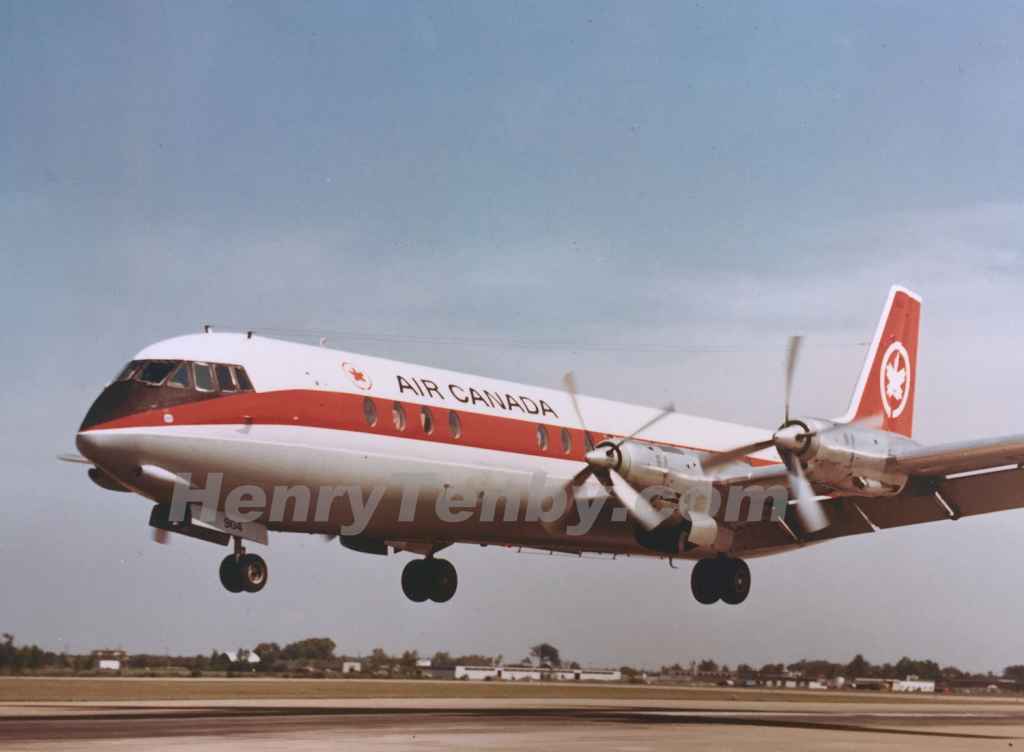
It was 0134 hours, Sunday, October 31, 1971. At Montreal International Airport, the brightly lit ramp was quiet. Because of the 11 pm curfew, the jets had stopped operating. The flashing beacons of the ramp trucks had disappeared one by one. Beyond the terminal building, the blue taxiway lights added to the stillness.
From their vantage point in the tower, the controllers could see a red rotating light moving slowly across the horizon, joining a long final for runway 06R.
“Montreal Tower, Air Canada 2458, we’re cleared for a visual approach.” That was Capt. S. F. Davis handling the radio; F/O Lorne Dyck was flying the airplane.
In the back were 16 passengers, including Kent Davis, Air Canada’s Vice-President of flight operations, and Capt. Bill Benson, Director of Flight Standards.
“Air Canada 2458, Montreal Tower. You’re cleared to land. Wind 060 at 12, altimeter 30.31.”
“Air Canada 2458.”
The flashing red light continued toward the runway as F/O Dyck descended tenderly. Suddenly the threshold was illuminated by three bright landing lights, and F/O Dyck set the airplane down without a ripple at 0139. As the airplane approached the terminal area, it first became a silhouette and then the unmistakable box-like shape of a Vickers Vanguard. The big prop-jet taxied to gate 43 and shut down. Thus, routinely and unceremoniously, 2458 marked the end of passenger service on the Vanguard, that rugged, magnificent aircraft that had served Trans-Canada Air Lines and then Air Canada for more than 10 years.
One who may have felt the end more than most was Capt. Benson. It was exactly 11 years ago on that night that he flew to England to begin his training on the Vanguard.
Selection of the Vanguard by TCA came after one of the most exhaustive studies of aircraft operating economics ever completed in the industry. The Vickers Vanguard was matched against all other potential medium—range airplanes, flying and projected, pure jet and turbo-propeller, before it was selected. Over TCA’s routes, which not only had to be averaged but factored to account for traffic density, the Vanguard came first. But many other factors, some not easily calculated came into the picture.
Some people in TCA were all for going pure jet; when the DC-9 came second in the economics study, this was all they wanted to know. But the ‘9’ was then a ‘paper’ airplane, Douglas Aircraft awaiting solid commitments before proceeding. Should the airplane be built, it would be out two years later than the Vanguard, putting TCA at a competitive disadvantage for that period.
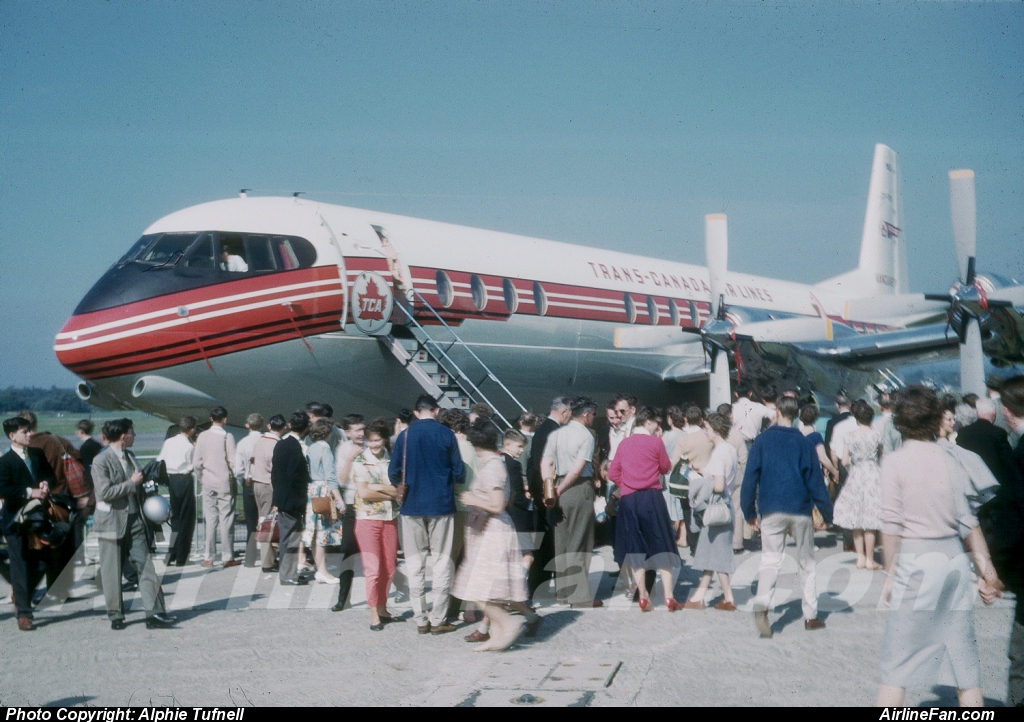
CF-TKB (293) fresh from the factory at Weybridge prior to delivery to Canada. In this instance the people do not detract from the photo.
(The project DC-9 was a different airplane from what was eventually produced. Range was to be 2.600 miles, definitely ‘medium’. The Boeing 727 filled that area and the ‘9’ as we know it was introduced in airline service as a ‘medium-short’ airplane in 1965.)
Also, the Vanguard had a cargo hold volume that no other passenger airplane could offer and freight projections indicated a needed capacity in that area as well. Still, the jet people had good arguments: definitely superior passenger appeal, longer projected life and, in the case of the DC-9, certain parts interchangeability with the DC-8, offering additional economics.
The Vanguard won out, however. On January 3, 1957, TCA announced the purchase of 20 Vanguards for a sum of $67.1 million. Eventually, three more were obtained, making TCA the world’s largest Vanguard Operator.
The first flight of the Vanguard took place on January 20, 1959 and the first TCA airplane began flying on July 9, 1960. In the July 22 issue, Aero Magazine reported the start of trials of the TCA Vanguard and, buried obscurer in the article, a small note to the effect that one of the differences between the TCA and British European Airways Vanguards was the fact that TCA had specified Skydrol 500A hydraulic fluid. Oh. How large that difference was going to be.
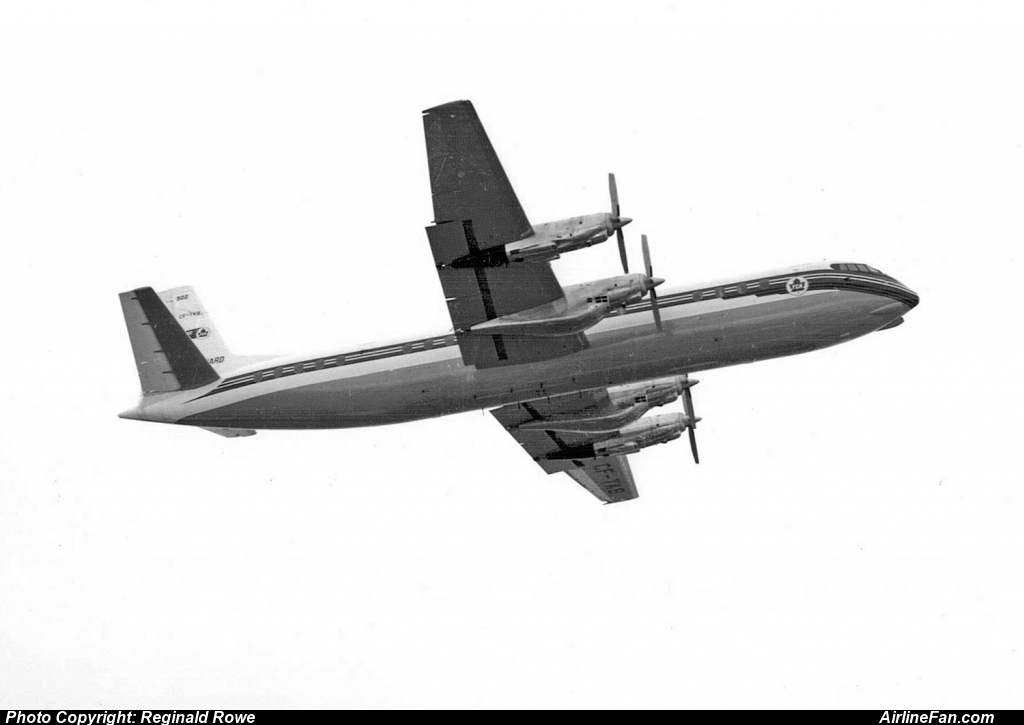
An unidentified Trans-Canada Air Lines Vanguard gets airborne from Vickers Weybridge, Surrey during an early test flight.
On Halloween 1960, five TCA pilots proceeded to Weybridge, England for the Vanguard course. They were Capt. George Lothian, then Superintendent of Flying, Capt. Ron Baker, TCA’s engineering test pilot, and Captains Bill Benson, Ed Marriott and Al Wilton, who were to be the initial instructors on the Vanguard and later check pilots.
After ground school. Captain Baker pursued a course befitting his capacity while the other four captains were paired in two groups for the flight training. The Vickers instructors were Dick Rymer, who was later killed in the BAC-III deep—stall accident, and Denis Hailey-Bell.
Vanguard had already developed teething problems, one of them being the failure of cabin compressors. While Vickers and Rolls—Royce were working on modifications, training carried on without pressurization or cabin temperature control, in the dead of winter.
Another problem evident at that stage was the presence of nose-wheel shimmies. Although they were found not to affect the integrity of the structure, the severity of the shimmies was as pronounced as it was unpredictable. Ron Baker got into the act; he went up with Dick Rymer and Bill Benson and they tried every possible way of landing to bring on the shimmy, unsuccessfully. After eighteen attempts, they decided to quit. Benson said: “Let’s try it once more.” On the nineteenth try, the airplane behaved as if it had landed on top of railroad ties.
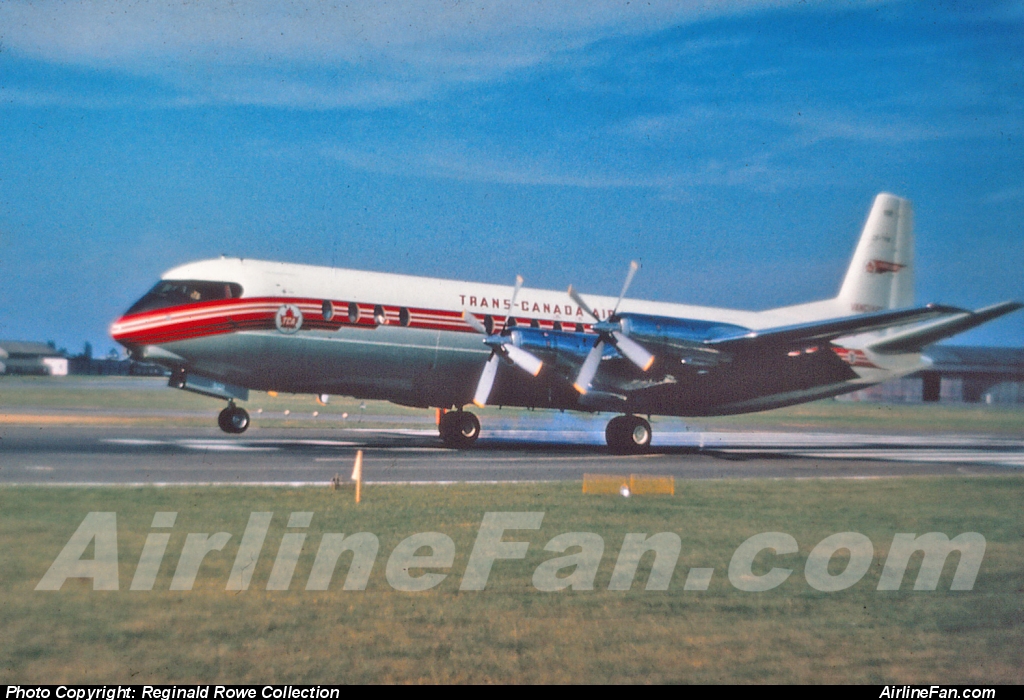
Trans-Canada Air Lines Vickers Vanguard CF-TKB being put through the paces at the Farnborough airshow, 1960 or 1961.
This problem, like many others typical of development flying, sent the engineers back to the drawing board and improvements were eventually made.
George Lothian and Al Wilton flew the first aircraft to Canada and the flight training program for the line pilots started. The Vanguard simulator was already installed and proved to be an excellent one. In addition to duplicating all systems, the Vanguard ‘box’ incorporated sound simulation. Engine noise, rush of air as in a rapid decompression, whine of an over-speeding propeller, even the tire squeal on landing. Once, during a simulator exercise, the instructor failed all four engines to see what the pilots would do.
They were “flying” at six thousand feet and their initial reaction was one of staring disbelief. The two pilots looked at each other for confirmation of reality then, questioningly, at the instructor sitting behind them. They were losing altitude, and fast: “Is this a power failure, like I mean, Quebec Hydro?” asked the pilot in the left seat. “No, it’s a power failure, like I mean, your engines!” answered the instructor. The pilots swiftly initiated the air-start procedure. With one going and one windmilling, the ‘aircraft’ was going in at a 30° angle. In desperation, the pilot in the right seat selected gear down. When they ‘hit’, the simulator fastidiously gave them the ‘screech-screech’ of the wheels.
The inaugural flight took place February 1, 1961, and was flown by Capt. Benson and Captains Dave Moir of Vancouver and Jack Smith of Toronto. The route was Montreal – Toronto – Winnipeg – Regina – Calgary – Vancouver. During the station stop in Winnipeg, it was discovered that the fire warning bell test circuit was un-serviceable. To ensure that the bell would work in case of an actual fire, the fire wire in each engine was grounded in turn by maintenance, the bell ringing in the cockpit each time. At the next stop, Regina, the procedure was repeated. Again in Calgary. But this time five bells were heard. Jack Smith, who carried an alarm clock in his bag, had set the thing to go off!
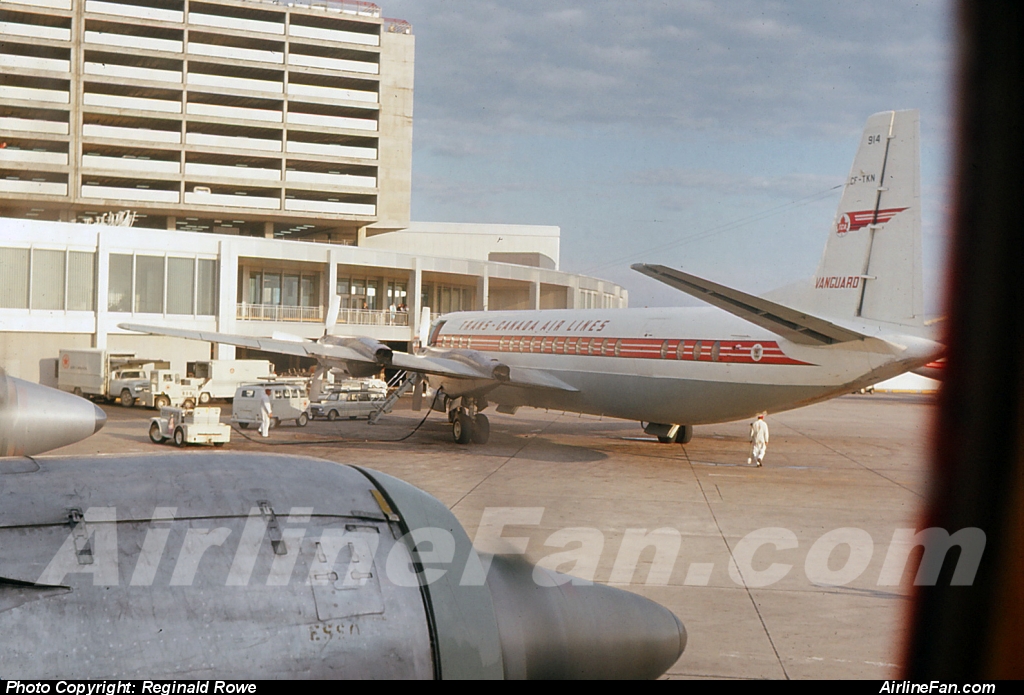
Trans-Canada Airlines Vanguard CF-TKN in a truly mouthwatering shot for the unabashed Vickers Vanguard fanatic. Obviously this 35mm kodachrome colour slide was taken on board a sister ship, with engines running. We can soak up the atmosphere of the then brand new Toronto Malton Terminal 1 with Trans-Canada Vanguard CF-TKN at the gate awaiting her passengers. Oh my lord … What a superb shot!
The early days of the Vanguard were beset by problems. One was vibration, with a resulting high noise level. By coincidence, it turned out that the fuselage length and the position and RPM of the props set up a natural vibration, which would slowly be transmitted through the fuselage all the way to the tail . . . and forth . . . and back . . . The Vanguard was a perfect tuning fork!
In concert with BEA and TCA, Vickers tackled the problem and a temporary procedure involved climbing with 5° flap. Later. Mainly through the addition of weights to the tailplane, the problem was solved, but not to everyone’s satisfaction. Already spoiled by jets, people expected the same of the Vanguard, something a turbo-prop is simply unable to deliver.
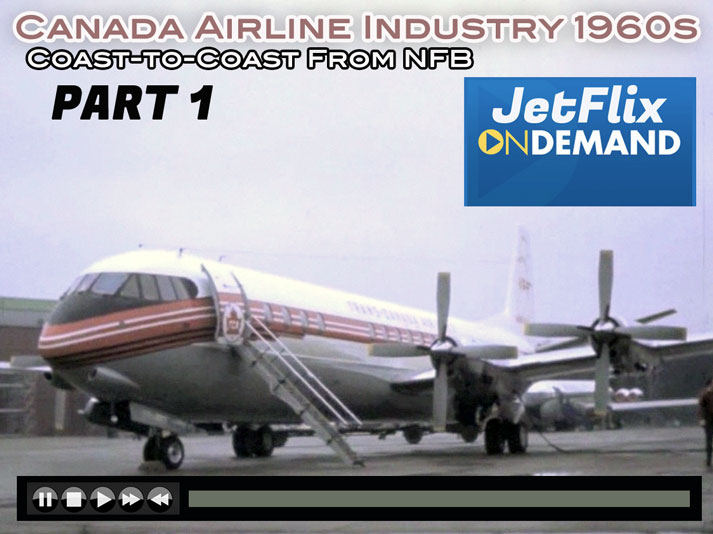 Choosing the new Skydrol 500A for hydraulic fluid was wise; it was super stuff. The fact that the seals were eaten away by it was another matter. Hydraulic problems were chronic. As one passenger stated, “When they can’t get the heels down, I get nervous; in that airplane, they couldn’t get them UP!” Well, sometimes. Actually, it took a sizeable loss of fluid before services would no longer operate. Other aircraft would be taxiing behind a Vanguard and advise that it was dripping hydraulic fluid; “We know, we know,” would be the reply.
Choosing the new Skydrol 500A for hydraulic fluid was wise; it was super stuff. The fact that the seals were eaten away by it was another matter. Hydraulic problems were chronic. As one passenger stated, “When they can’t get the heels down, I get nervous; in that airplane, they couldn’t get them UP!” Well, sometimes. Actually, it took a sizeable loss of fluid before services would no longer operate. Other aircraft would be taxiing behind a Vanguard and advise that it was dripping hydraulic fluid; “We know, we know,” would be the reply.
That problem was solved by the replacement of seals and other difficulties were being surmounted as well. Schedule reliability increased gradually so that by November, 1961, on-time performance had reached 71 per cent compared to 41 per cent two months previously.
That winter, the Vanguard was introduced to the South. Still unsatisfied with the aircraft’s reliability, TCA wanted a back—up for what was to be the Vanguard’s premier run. It was decided to stand a Lockheed Super Constellation next to the Vanguard on the ramp so that if the latter packed up at the last minute, the passengers would be transferred to the waiting Constellation. Since Toronto did not have ‘Connie’ crews, a Montreal crew would stay at a motel close to the airport, ready to lend support. If the Vanguard worked, they would return to the motel. After a few days they would go back to Montreal and be relieved by another crew. Sometimes they got to fly, most often not. That operation came to be known as the ‘Conguard’!
Dave Tennant is now Air Canada’s Vice-president — Personnel but was formerly Vice-president — Operations and had a hand in choosing the Vanguard for TCA. He said: “The Vanguard was the best for the mission; when we looked at the cost projections, it was a winner. The belly compartment with its great cargo capacity just added to that.”
The Vanguard was a newer airplane than the first generation of jets but the prestige was stolen by the Douglas DC-8 which TCA had introduced in Canada ten months earlier. Not only was the jet smoother and quieter but the ‘8’ was glamorous.
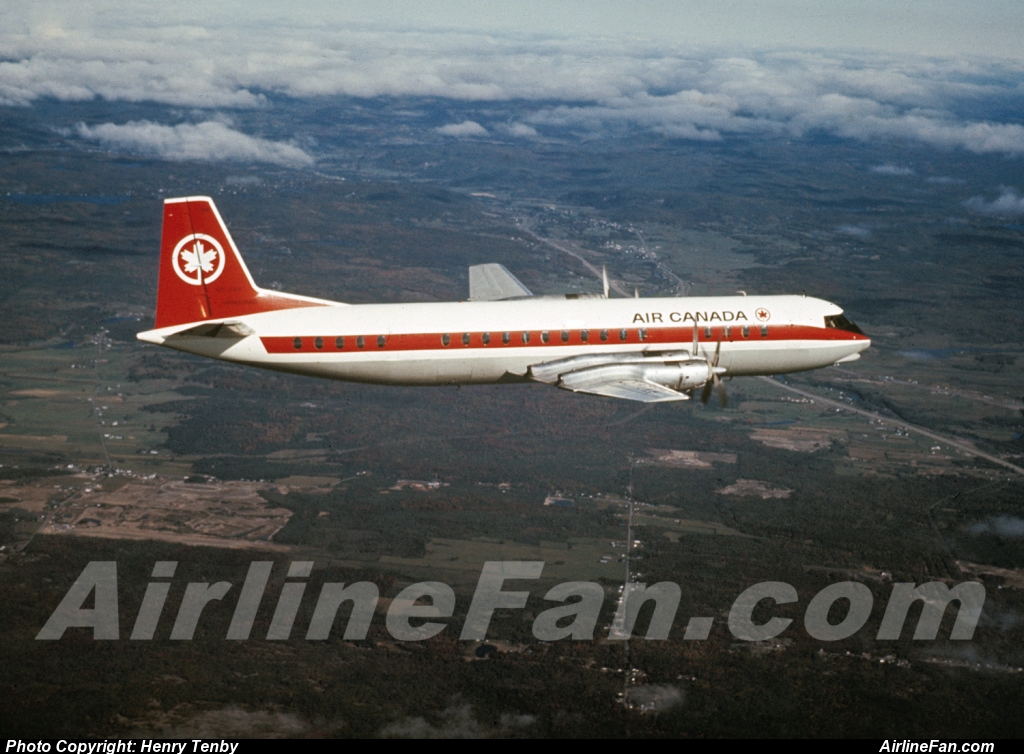
When Trans-Canada Air Lines was renamed Air Canada in 1965, all the types were taken up for a new round of air-to-air publicity shots, which was the occasion for this lovely image, originally from Air Canada archives. This photo of CF-TKP is actually a photo teaser from my book “Air-To-Air: Ultimate Airline Photography” which showcases 175 all-colour pages of classic propliners and classic jetliners photographed inflight. You can purchase your own copy of my book right here: https://www.henrytenby.com/product/air-to-air-ultimate-airline-photography-by-henry-tenby/.
People were spoiled: they did not realize that the jet was still basically a long-range airplane. At the time that the Vanguard was introduced, two medium-range pure jets were flying, the Convair 880 and the British-built De Havilland Comet 4.
Neither presented anywhere near the passenger seat cost economics of the Vanguard over the routes flown by TCA and their purchase would have resulted in higher fares with little decrease in block times. Both being very thirsty aircraft. It was somehow forgotten that most of the world’s medium-range routes were still being flown by pistons.
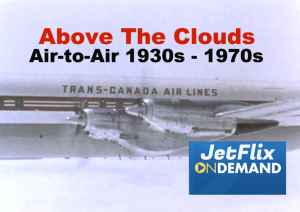 In the Vanguard, the value dollar for dollar, was unsurpassed. The Vanguard offered the best travel bargain. The Economy cabin had larger seats and was superior to that of any short/medium-haul aircraft then flying. The first-class section was magnificent. Isolated at the rear, the quiet little club remains in the eyes of many a unique travel experience. And Vanguard’s over-sized oval windows (like the smaller Viscount) provided passengers with unparalleled views.
In the Vanguard, the value dollar for dollar, was unsurpassed. The Vanguard offered the best travel bargain. The Economy cabin had larger seats and was superior to that of any short/medium-haul aircraft then flying. The first-class section was magnificent. Isolated at the rear, the quiet little club remains in the eyes of many a unique travel experience. And Vanguard’s over-sized oval windows (like the smaller Viscount) provided passengers with unparalleled views.
The safety record of the Vanguard is exceptional.
The aircraft was introduced in service with perhaps a larger than usual share of teething problems yet it progressed through the ‘learning curve’ without a major accident. The later fatal crash of a BEA Vanguard at Heathrow, England was attributed to pilot error and in Air Canada service a lone fatality resulted from a passenger being killed when a flight unexpectedly encountered severe clear air turbulence over Rocky Mountain House. Alta. In a landing accident at Antigua and in a wheels-up landing at Montreal, no one was injured. It can be said that the Vanguard, of itself, has never as much as scratched anyone. (At the time of writing, the tragic BEA Vanguard accident in Belgium was still under investigation.)
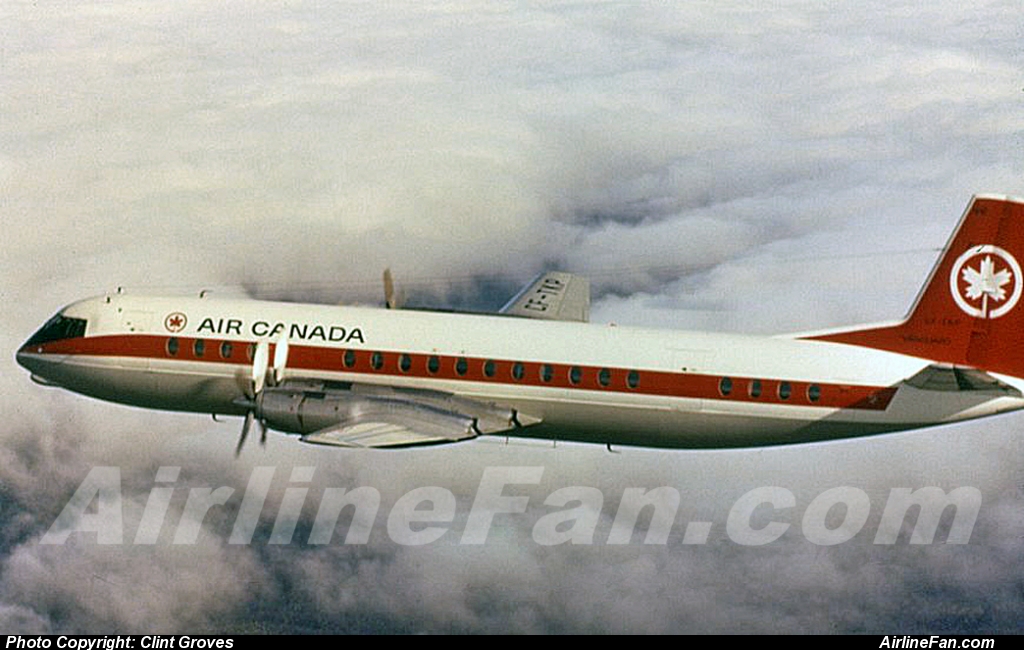
Yet another nice profile view of Air Canada Vickers Vanguard CF-TKP during her air-to-air company name rebrand publicity shots back in 1965, from Air Canada archives.
Of the wheels-up landing in Montreal following a hydraulic failure, certain anecdotes are worthy of mention: Captain Ed Marriott, in command of the flight, was in communication with TCA via the company frequency. Since this was the first year of Vanguard operation, everyone was not only concerned but also a bit in the dark as to why the landing gear would not, at least, free-fall. Through a communications set-up, Capt. Marriott was put in direct contact with a Vickers engineer at home in bed in Weybridge, England!
Aware that they would circle for quite a while, Capt. Marriott authorized the serving of drinks to the passengers. The stewardess advised that she had sealed the bar when ‘in range’ of Montreal, as per company regulations. “Well, open it again,” directed Capt. Marriott. This she did, by bashing it open with the fire axe! Air Canada has always been a market leader in terms of the highest levels of passenger service.
The hydraulic off-load switch was once a problem. When the switch was in the ‘off’ position, the system was ‘on-loaded’ (pressurized), and vice-versa. Well, think about it: if the off-load switch is off, then you’re on-loaded, right? Of course, perfectly logical. But try to teach it in the class- room. TCA finally changed it to be more in tune with the Canadian mind and linguistics; when the switch said ‘on’, you were ‘ON’. Don’t think, baby, just fly the plane!
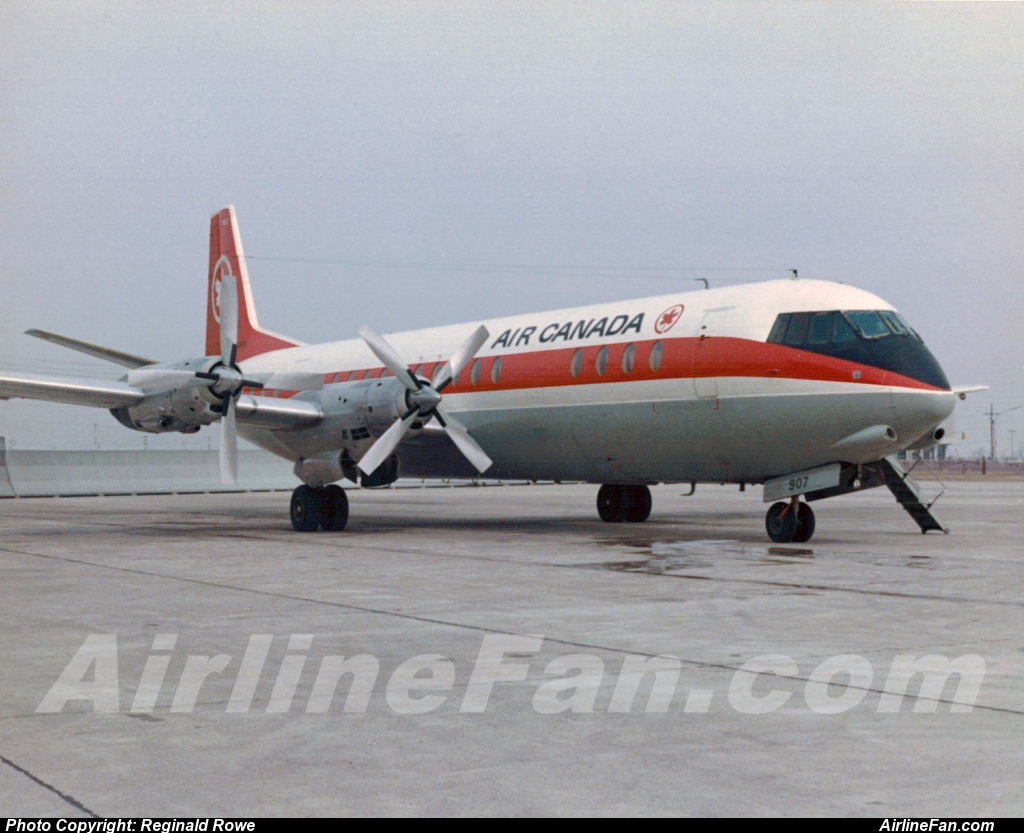
Air Canada Vickers Vanguard CF-TKG looks amazing sitting on the Montreal Dorval apron back in 1967.This Vanguard was sold to Air Holdings Limited as G-AYLD in 1969, as part of a trade-in deal with Lockheed towards new L-1011s. Lockheed re-sold the Air Canada Vanguards to Air Holdings for onward disposal. I don’t like the word “disposal” when applied to Vickers Vanguards.
Another dandy was the ‘Chime Isolate’. The Vanguard galley control panel incorporated a number of switches for diverse services and these were indicated above each switch. One such switch was marked ‘Chime’; just under the word ‘chime’ was ‘Isolate’ for turning it off and below the switch was printed ‘on’ for, naturally, having the thing on. A lot of stewardesses read that as the ‘Chime Isolate’ so that if it was selected ‘on’ the chime would be isolated. They therefore moved the switch to the other position, in effect turning it off
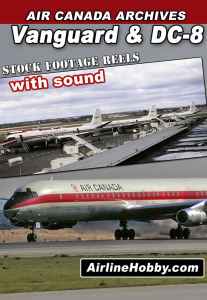 In the cockpit, pilots would hit the call button with ever-increasing frenzy, wishing for a cup of coffee. At the end of the flight, the pilots would say to the ‘stew’: “We called you a hundred times, where were you?” And the ‘stew’ would answer: “I never heard the chime; I guess it doesn’t work.” The pilots would then write in the maintenance log book that the chime was unserviceable. Maintenance would try it, find it in perfect working order and enter in the book: ‘Ground-checked Serviceable’. They would then leave the switch in the ‘on’ position.
In the cockpit, pilots would hit the call button with ever-increasing frenzy, wishing for a cup of coffee. At the end of the flight, the pilots would say to the ‘stew’: “We called you a hundred times, where were you?” And the ‘stew’ would answer: “I never heard the chime; I guess it doesn’t work.” The pilots would then write in the maintenance log book that the chime was unserviceable. Maintenance would try it, find it in perfect working order and enter in the book: ‘Ground-checked Serviceable’. They would then leave the switch in the ‘on’ position.
The next crew of stewardesses would board the aircraft, change the switch over and the whole cycle would start all over again. It took years for us stupid Canadians to figure that one out.
Yet another example of the difference between British and Candian logic and linguistics.
It is impossible to describe the propeller system. Suffice it to say that it has nine protective devices to prevent the props from going into ‘ground-fine’ in the air. Glen Cawker of Air Canada says that when the Englishman who designed the propeller was finished with it, they took him away.
What was it like to fly the Vanguard? Well, it was much more than flying a big Viscount. Bill Benson, who is now Air Canada’s Director of Flight Standards, said: “I loved the airplane; it was a great rudder airplane, it made you fly more, The Vanguard had the finest cockpit ever designed; the lighting was superb. It was simply magnificent over the lights of Montreal.”
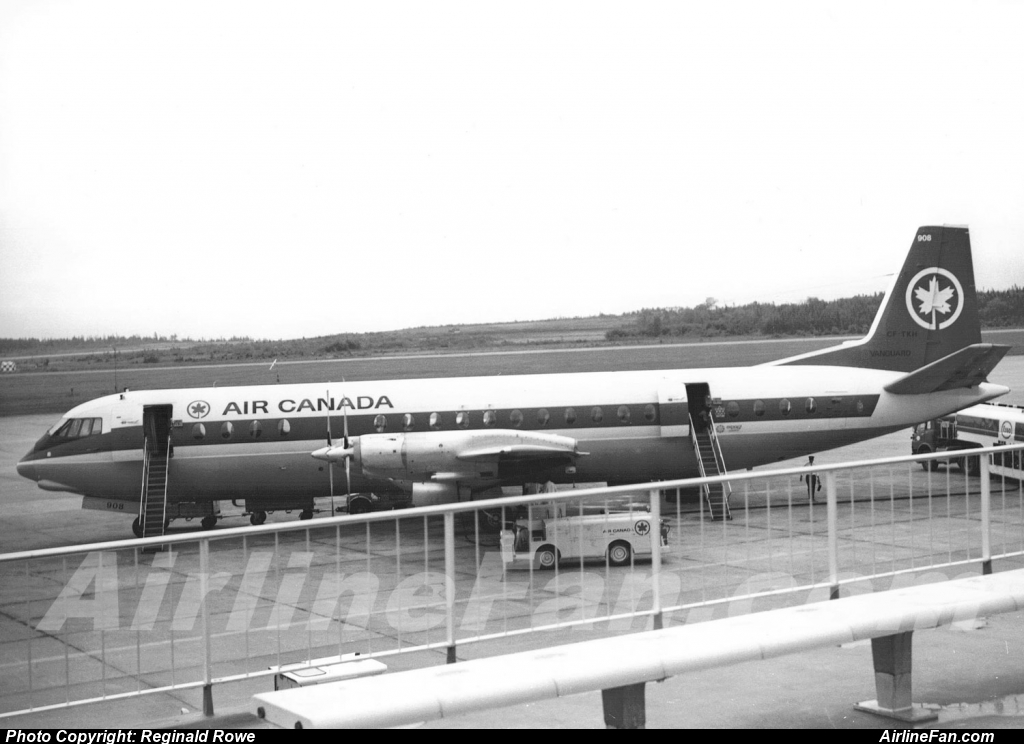
Air Canada Vickers Vanguard CF-TKH awaits passengers on the Dorval apron as viewed from the once sprawling open air observation deck at Montreal. In this case the photo was taken in 1967, and the Vanguard is carrying the small Expo 67 logo by the right sill of the rear passenger door. CF-TKH was sold to Europe Air Service in 1972 as F-BTOU.
Brian Trubshaw, who was later to test-fly the Concorde, was Chief Test Pilot on the Vanguard project. He demanded more space in the cockpit, knowing from experience that the dimensions would be cut back later. This time the boffins listened to him. The result. The Vanguard had, and still has, the most spacious flight station of any commercial airplane. As one stewardess expressed when she first set foot inside the Vanguard cockpit: “You could have a dance in here!”
“But the airplane was a great leveller,” adds Benson. “Most guys came on it from the Viscount and were used to greasing it on.” Said Capt. Gerry Lloyd, Air Canada’s Flight Operations Director, Toronto Base: “The Vanguard was a horse of a different wheelbarrow.”
And how! At the beginning, the landings were atrocious. Pilots would cross the fence, close the throttles and. . . crunch! Well, isn’t that the way we were all taught? The Vanguard, with four wide, 141/2 foot diameter props was different, all right. First, when the throttles were closed, the props went against the ‘flight fine’ stops, a relatively flat pitch; second, and partially as a result of the first, the immediate speed reduction caused the airplane to sink rapidly and contact the runway. ‘Contact’ is the key word here.
The plane had wings and it had engines; there just had to be some way of putting the two together and decently depositing the Vanguard on the runway. “No. There is no way,” said one. Said another: “Where you close the throttles, that’s where you land.”
Said yet another, despairingly: “Any landing you walk away from is a good one.” But a few were having some success and the word gradually filtered to the troops. The guys were no longer crashing them on, but the airplane remained a challenge right to the end.
Stopping distance was phenomenal. With over twice the weight of the Viscount and additional speed over the threshold, the Vanguard could be stopped shorter, even without reversing. Putting the propellers into the ‘ground’ mode after touchdown sent them to aerodynamic 0°, effectively offering the slipstream a veritable barn door. On scheduled airport runways, reverse was never used, brakes hardly. Yet, if you needed them, they were there. Tremendous security.
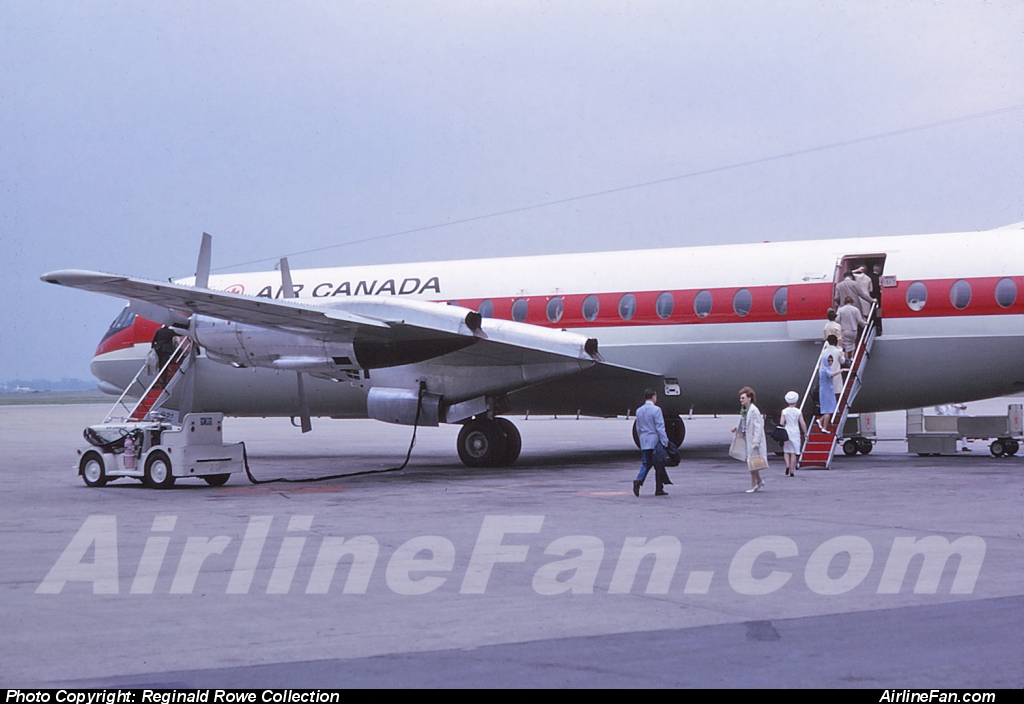
Passengers boarding Air Canada Vickers Vanguard CF-TKU at Montreal Dorval, June 1965. This Vanguard was sold by Air Canada to Air Holdings Limited in 1969 as G-AZNG in trade for Lockheed L-1011s.
Air Canada Vickers Vanguard CF-TKH awaits passengers on the Dorval apron as viewed from the once sprawling open air observation deck at Montreal. In this case the photo was taken in 1967, and the Vanguard is carrying the small Expo 67 logo by the right sill of the rear passenger door. CF-TKH was sold to Europe Air Service in 1972 as F-BTOU
Three pilots hold the distinction of having flown every Vanguard that was ever built. They are Capt. Hans Schlieper, First Officer Ike Jones and former First Officer Doug Vann. All three were TCA pilots who flew with BEA after being laid off by the former. They later returned to their homeland and flew the Air Canada Vanguards. Capt. Schlieper, with more than a little naval tradition, expressed his feelings: “She was the last of the four-masted square riggers. I detest the thought of being a wooden man in an iron ship, with no bridge to pace.”
Capt. Lloyd Warriner, who alternately flew the line, instructed and was a check pilot on the Vanguard referred to it, and still does, as the ‘World’s Greatest Airplane’.
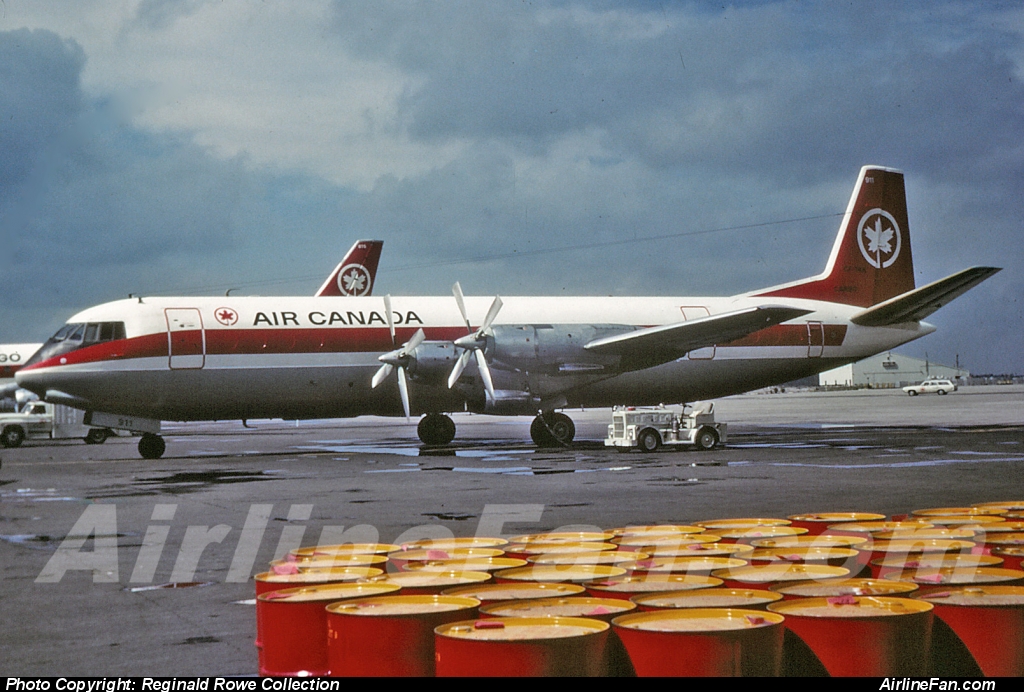
Air Canada Vickers Vanguard 952C CF-TKK was the only Vanguard in the fleet converted to pure freighter, as explained in the article above. And seen in this photo at Toronto Malton in August, 1970. In 1972 this Air Canada Vanguard was sold to Europe Aero Service as F-BTYB where it continued to operate through the decade of the 1970s as a Perpignon-based cargo hauler.
Perhaps no other transport aircraft imparted such an exhilarating feeling to its pilots and it appears that with automation, none ever will. Pilots loved the Vanguard with an emotion like that held for the DC-3.
If you should hear that unmistakable sound, if you should see that unique shape, you’re not dreaming; there is still one Vanguard in Canadian skies. CF-TKK. It is a freighter, Air Canada’s lone experiment at modifying the Vanguard for cargo operation. No additional aircraft will be converted as it cannot be justified economically. However, this freighter will continue in service for an indefinite period.
When they pass TKK in their faster jets, former Vanguard pilots will not look down on it. They will let their eyes languish a few seconds before returning their attention to the horizon, thinking . . . there she goes, the last of the great prop-liners.
Tags: air canada, TCA, Trans Canada Air Lines, Vanguard, Vickers




No comments yet.